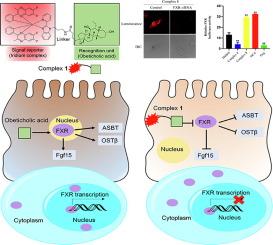当前位置:
X-MOL 学术
›
J. Adv. Res.
›
论文详情
Our official English website, www.x-mol.net, welcomes your
feedback! (Note: you will need to create a separate account there.)
Tailoring obeticholic acid activity by iridium(III) complex conjugation to develop a farnesoid X receptor probe
Journal of Advanced Research ( IF 11.4 ) Pub Date : 2024-10-28 , DOI: 10.1016/j.jare.2024.10.028 Dou Niu, Xiaolei Wu, Yuxin Zhang, Xueliang Wang, Daniel Shiu-Hin Chan, Shaozhen Jing, Chun-Yuen Wong, Wanhe Wang, Chung-Hang Leung
Journal of Advanced Research ( IF 11.4 ) Pub Date : 2024-10-28 , DOI: 10.1016/j.jare.2024.10.028 Dou Niu, Xiaolei Wu, Yuxin Zhang, Xueliang Wang, Daniel Shiu-Hin Chan, Shaozhen Jing, Chun-Yuen Wong, Wanhe Wang, Chung-Hang Leung

|
The farnesoid X receptor (FXR) is a crucial regulator in the intestine, maintaining bile acid homeostasis. Inhibiting intestinal FXR shows promise in managing inflammatory bowel and liver diseases by reducing bile acid accumulation. Additionally, changes in FXR expression could serve as a potential biomarker for intestinal diseases. Therefore, developing an imaging probe for FXR holds significant potential for the early detection, simultaneous treatment, and monitoring of FXR-related diseases.
中文翻译:

通过铱 (III) 复合物偶联来定制奥贝胆酸活性以开发法尼醇 X 受体探针
法尼醇 X 受体 (FXR) 是肠道中的重要调节因子,可维持胆汁酸稳态。抑制肠道 FXR 通过减少胆汁酸积累,有望控制炎症性肠病和肝病。此外,FXR 表达的变化可以作为肠道疾病的潜在生物标志物。因此,开发 FXR 成像探针对 FXR 相关疾病的早期检测、同步治疗和监测具有重要潜力。
更新日期:2024-10-28
中文翻译:

通过铱 (III) 复合物偶联来定制奥贝胆酸活性以开发法尼醇 X 受体探针
法尼醇 X 受体 (FXR) 是肠道中的重要调节因子,可维持胆汁酸稳态。抑制肠道 FXR 通过减少胆汁酸积累,有望控制炎症性肠病和肝病。此外,FXR 表达的变化可以作为肠道疾病的潜在生物标志物。因此,开发 FXR 成像探针对 FXR 相关疾病的早期检测、同步治疗和监测具有重要潜力。


















































 京公网安备 11010802027423号
京公网安备 11010802027423号